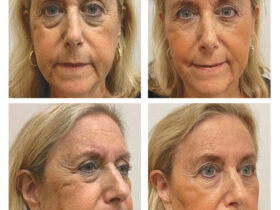By Dr. Anita Grassi
Vitiligo is a medical condition that leads to loss of pigmentation in the skin creating white spots. It occurs in about 1% of the population and affects both men and women equally. The onset of vitiligo can occur at any age but half the time it develops in patients younger than 20 years old. All skin types are susceptible, but the discoloration is more visible and hence more disfiguring in people of color.
The depigmented patches of vitiligo commonly involve the face, hands and feet and often encircle the eyes, nose, and mouth. Vitiligo frequently develops in skin folds such as the armpits and groin as well as sites of trauma or friction such as elbows and knees, a response called the Koebner phenomenon. It can even occur in areas of sunburn. It is usually bilateral and symmetric, affecting both sides of the body, but can be unilateral and localized. White hair may develop on the scalp, brows, and eyelashes. Loss of pigmentation can become more widespread, but the progression is slow over months to years.
Vitiligo is considered an autoimmune condition in which the body’s own T-cells destroy the pigment cells or melanocytes in the epidermis. It is associated with other autoimmune disorders including thyroid disease, pernicious anemia, Addison’s disease, and alopecia areata. Vitiligo needs to be distinguished from other skin conditions that can likewise lighten skin. A dermatologist can generally make the diagnosis by clinical features alone or with the aid of a Wood’s lamp examination to enhance the contrast in color. A skin biopsy may be necessary to demonstrate the absence of melanocytes in the affected areas.
Treatment of vitiligo is based on a two-tiered approach: first suppress the attack on the melanocytes and then stimulate re-pigmentation. Vitiligo can be stubborn requiring months to years of treatment and complete cure may not be possible. However, much research is ongoing and new medications are on the horizon. Current treatments include topical cortisone creams and calcineurin inhibitors (tacrolimus, pimecrolimus) to decrease inflammation and light-box or phototherapy to stimulate pigmentation. In 2022 the FDA approved a topical JAK inhibitor (ruxolitinib) which blocks the overactive immune response, resulting in significant improvement of lesions especially on the face. Other oral JAK inhibitors are currently under investigation.
If you suffer from vitiligo, remember the following guidelines:
. Always practice good sun protection. The white patches sunburn very easily because they have lost melanin, the natural pigment that protects the skin from harmful UV rays. Apply sunscreen with SPF 30 or higher, wear hats, protective clothing and avoid sun exposure during peak hours.
. Likewise avoid tanning beds or sun lamps. This is especially true if you have a lighter complexion. Not only do you risk a sunburn, but tanning increases the contrast between your natural skin tones and the white patches, making them more obvious.
. Treat your skin gently to prevent triggering new lesions. Vitiligo can develop after injury to the skin including abrasions, sunburns, tattoos, chemical peels, and some laser procedures.
. Consider camouflage for discoloration. Makeup may be useful for facial lesions. Self-action tanners and skin dyes that contain dihydroxyacetone will temporarily darken the skin and help blend pigmentation in larger areas.
Vitiligo is more than simply a cosmetic concern. Consult your dermatologist to confirm the diagnosis and develop a treatment plan that works best for you.
DR. ANITA GRASSI
Board Certified Dermatolgist
Dr. Anita Grassi is a board-certified dermatologist who joins Skin Wellness Physicians after a long career in both academic and private practice in the Boston area. She spent 30 years in practice at the Dermatology Laser and Cosmetic Center at xpert for Massachusetts General Hospital in Boston, MA, where she gained experience in cutting-edge laser treatments of skin disorders. She also served on the faculty of Harvard Medical School as an assistant professor and was instrumental in training many residents and fellows in medical dermatology, laser, and cosmetic procedures. Furthermore, she co-founded a private practice in Watertown, MA, bringing the same level of skillful dermatologic care into the community setting.
239.732.0044
www.SkinWellnessFlorida.com









